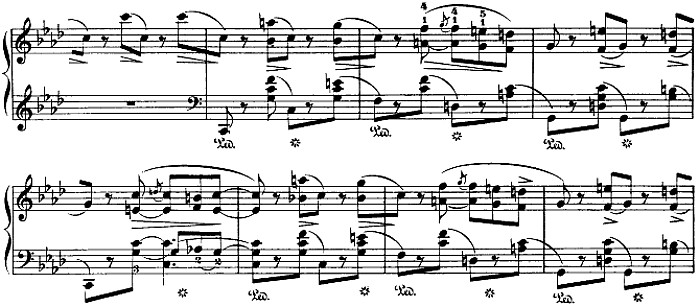
I n everything Chopin wrote, no matter how complex and virtuosic, that powerful simplicity is there at the core. Although he wrote some very difficult and impressive stuff, the ultimate effect of his music, I feel, should never really be to ‘impress’. But that’s exactly what the pianists we usually hear are striving to do: impress the contest judges, the critics, the public. The world we classical performers live in gives us very little room not to play big ‘show’ pieces, or make everything we play into one... Chopin’s third ballade suffers particularly from this problem. The ballades are all difficult, but No. 3 is the easiest of them—sort of like the shortest Himalaya. It seems as though all the star performers I’ve heard end up trying to make it as hard as the others, plowing through it with virtuosic flare, and thus trivializing it. [And how wonderful it is when, instead, someone like Richard Goode plays this piece with selfless transparency. –DSM]”M y favorite part of Richard Goode’s performance last night in Kansas City [a program that included Mozart, Beethoven, Schumann, and Chopin] was the Chopin Ballad No. 3, Op. 47. This 9-minute piece is maybe the strangest of Chopin’s four ballades, on account of its unrelenting optimism. Goode’s expressive dexterity handles the staggering complexity with seeming ease and imparts a vigor suffused with warmth... perfect for this sweet, cheerful work.
— Paul Cantrell blog, In the Hands, 02-MAR-2005..
G entle A-flat 6/8-meter dolce, evoking donkeys Chopin observed in the hills of Majorca? Donkeys with jobs, but happy jobs that they enjoyed doing.
T he technique [of musical gesture] is perhaps a musical version of what is referred to as a ‘suture’ in film theory: placing the camera in such a way that it functions as the eye of the protagonist of the film, thereby drawing us, as unwitting spectators, to become the subject of the film ourselves, since we share the same visual field and same [Majorcan] point of view.”W hat a narrative trajectory! What storytelling! Social media of 1841! Our minds engage, imagination runs free, and we ‘friend’ or ‘follow’ this peripatetic, vacationing Chopin voice from the beginning to the end. The feeling is physical, not just emotional; it coheres—for Goode, and for us in the audience—throughout the piece, all the way to the satisfying, happy ending. For example, the motion from C (mm. 230, 232) down to the E-flat (mm. 231, 233) suggests the subsequent plunges to the low A-flat at the end. Energy flows! We “feel” the path that we are on, anticipate things along the way, anticipate them accurately. And this experience of uncanny accuracy is part of what is pleasant and thrilling for us: in material that is this complex and unpredictable, we don’t usually experience ourselves as being so graceful or right as this. We love being unexpectedly better than we are!
— Patrick McCreless, in Almén & Pearsall, p. 13.
U ltimately, our minds and bodies gladly go everywhere Chopin’s and Goode’s narrative aims to take us. Theirs is a higher-order virtuosity that doesn’t strive to impress. It strives only to reveal what’s True, to tell this true story. But it’s not just ‘telling’, not just a musical ‘text’. The human body is involved—fingers, arms, flesh, nerves, mortal gifts, physical mass. The higher-order virtuosity inhabiting the body averts its gaze and embodies Laws of Physics in action—beauty incarnate; a kind of transcendence—something for which we surely hadn’t planned on our Friday night out, and something for which we feel thrilled and grateful. Bravo!

V iewed as a sign, ‘formative repetition’ refers to what is repeated: it is usually a marker of segmentation, a grammatical feature. When a figure is repeated more than once, the attention begins to be attracted by the repetition itself; instead of focusing on the repeated material only, we focus on the act of repetition as an activity signifier per se and seek a symbolic interpretation of it. It is then a sign, not of segmentation or grammar, but of connotative meaning. It evokes extra-musical associations of... emphatically [re-]emphasized speech, dancing, laughing, etc.”
— Raymond Monelle, p. 88, quoting Lidov.
- Richard Goode page at Frank Salomon Assoc
- Richard Goode page at Nonesuch.com
- Chopin F. Ballade No. 3, Op. 47 score at IMSLP.org
- Agawu K. Music as Discourse: Semiotic Adventures in Romantic Music. Oxford Univ, 2008.
- Almén B. A Theory of Musical Narrative. Indiana Univ, 2008.
- Almén B, Pearsall E, eds. Approaches to Meaning in Music. Indiana Univ, 2006.
- DSM. Richard Goode's emergent Chopin. CMT blog, 02-OCT-2011.
- Hatten R. Interpreting Musical Gestures, Topics, and Tropes: Mozart, Beethoven, Schubert. Indiana Univ, 2004.
- Huron D. Sweet Anticipation: Music and the Psychology of Expectation. Bradford, 2008.
- Monelle R. Linguistics and Semiotics in Music. Routledge, 1992.
- Nattiez J-J. Music and Discourse. Princeton Univ, 1990.
- Pearsall E. The structure of conflict: Dialectics and the play of personae in Chopin’s Op. 27, No. 2. Indiana Theory Rev 2003;24:107-27.
No comments:
Post a Comment